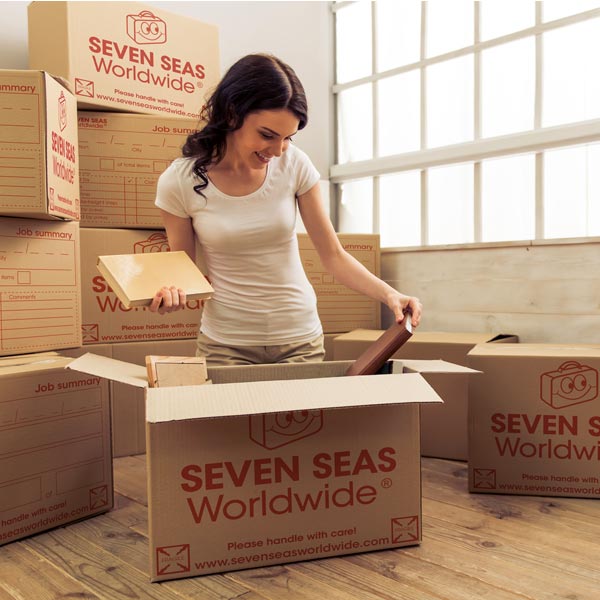Before packing, check this list of items prohibited from entering a particular country or region.
Everything you need to know about how to pack clothes for shipping
Shipping clothes abroad may seem straightforward, but ensuring they arrive at their destination in top condition requires thorough planning. Knowing the best techniques is essential, whether sending one t-shirt or an entire wardrobe. From using the appropriate packaging materials to choosing the best shipping method, each step is crucial in protecting your garments during transit.
This guide provides a comprehensive overview of the entire process, including how to prepare, pack and ship clothes efficiently and securely. Whether you're a seasoned shipper or a first-timer, these tips will help you navigate the clothes shipping process with ease.
Best packaging materials for shipping clothes
Begin by gathering your packing materials, such as parcel tape, a box-cutting knife and some sturdy shipping boxes. Set aside plenty of time to avoid any last-minute rush-packing. Seal the bottom of your box using three layers of overlapping parcel tape, then wrap it around the bottom with more tape for added security. Repeat the process at the lid when your box is full.
Here are some more packaging options:
- Bubble wrap: an extra layer of protection for delicate, expensive or sentimental clothing to protect them from rubbing against each other and to hold shape.
- Tissue paper: ideal for wrinkle-prone garments, delicate fabrics or clothes with embellishments, such as buttons or sequins.
- Paper bags: to prevent snagging and allow for air circulation.
- Packing peanuts: soft foam pellets that provide extra cushioning against impacts.
- A marker pen and blank stickers: to accurately label each box for its contents and intended use, e.g. "summer clothing for wardrobe number two".

What kind of shipping boxes are available?
We offer double-walled cardboard shipping boxes to protect your shoes, clothes, and accessories during long overseas journeys. Our most popular containers are Large (best for bulky items like jackets, coats and hats) and Standard (perfect for shoe boxes, jeans, t-shirts and jumpers). See below for precise dimensions. Order more boxes than you need — if any remain unused and in brand-new condition, we'll collect them for free.
Please note that our drivers can't collect containers weighing over 30kg/66lbs for your and their safety. Weigh each box on bathroom scales. If a container exceeds the limit, move some items to a lighter box.

Large box
External dimensions:
61 x 51 x 41cm / 24 x 20 x 16.14 inches
Best for:
- Sports equipment
- Clothes
- Bedding

Standard box
External dimensions:
51 x 41 x 31cm / 20 x 16.14 x 12.2 inches
Best for:
- Files and papers
- Books
- Children's toys


How to pack shoes
Packing shoes, such as boots, sneakers, sandals and high heels, for a move requires care and organisation. Before you begin, ensure all footwear is thoroughly clean and 100% dry; otherwise, mould will form during transit and could result in fines and delays.
Fill your shoes or trainers from the toe area to the middle with socks or crumpled packing paper to help maintain their shape and provide cushioning. However, avoid overstuffing, as you may end up with an unwanted bulky shape on arrival. Then, tie up the laces, zip up any zippers and cover each shoe in tissue paper, plastic sheets or bubble wrap.
If possible, pack your shoes into their original boxes to avoid damage from other shoes and to protect them from dust. If your shoes have no original boxes, use plastic shoe bags, plastic wrapping, or plastic bags tied at the ends. Avoid delays by facing all shoes upwards for ease of inspection.
Finally, carefully stack each box and bag inside larger shipping boxes until complete, with heavy boxes at the bottom to avoid crushing.
Clean shoes in 4 easy steps:
It's especially important to ensure your shoes are thoroughly clean and dry when shipping to Australia and New Zealand. These countries enforce strict customs regulations preventing the importation of any personal effects contaminated with organic materials.
So, please place shoes at the top of your shipping box or suitcase for easy inspection by customs officials.

Set aside fragile pieces such as beaded tops or sequined dresses, and wrap them individually for added protection.
Preparing clothes for shipping
Consider decluttering before shipping to save money and lessen waste. After all, the less you ship, the cheaper it will be! A simple rule is that it can probably go if you haven't worn it in over a year. Then, create a detailed inventory of the clothes you want to ship.
You can sell unwanted clothes, shoes and accessories in good condition on auction sites like eBay and Facebook Marketplace. Take whatever doesn't sell to charity shops and recycling centres.
Before packing, thoroughly clean and dry every item of clothing according to the instructions on the label. Then, closely inspect the garment to ensure it's blemish-free and in good condition. Next, organise everything by type so they can be shipped together and quickly stored on arrival.
Set aside fragile pieces such as beaded tops or sequined dresses, and wrap them individually for added protection. Finally, when packing shipping boxes, place heavier items at the bottom to protect the lighter items above.
How to pack clothes for moving
Packing clothes for international removal requires careful planning to ensure they arrive at your new destination in an organised and damage-free manner.
Fold clothes, such as t-shirts, jeans and jumpers, neatly and place them in sturdy shipping boxes.
Use vacuum storage bags* for seasonal clothing or items you won't need immediately to save space. The compression created reduces volume, making them easier to transport and store. All you need to do is place your clothing items inside the bag, remove air using a vacuum cleaner and seal it shut. Please ensure that any extra weight produced due to extra space does not exceed our 30kg/66lbs limit per container.
If packing fragile items such as glass, place them inside plastic bags and position them away from the sides of your box, surrounded by soft materials. Otherwise, the shattered glass may become embedded in your clothes.
Top tip: set aside small items of clothing like socks, underwear or scarves to fill gaps in boxes — it maximises space and provides protective cushioning during long shipping journeys!
*Seven Seas Worldwide doesn't endorse these products.
How to ship clothes wrinkle-free
Ship clothes wrinkle-free by folding each item according to its design and smoothing out any creases before placing them into a box or suitcase. Doing so helps maintain their condition, shape and smoothness during shipping.
Add tissue paper or plastic dry cleaning bags between each layer to prevent friction. Also, consider folding your clothes in a crisscross manner as you pack. For example, placing a t-shirt between the folds of a pair of trousers, with a layer of paper or plastic between them.

How to roll clothes for packing
When packing, rolling clothes, also known as "army rolling", is a space-saving game-changer that works for various garments. Plus, it makes it easier to locate specific items when unpacking.
Here's how it works in three easy steps:

Prepare the garments you want to roll:
Lay the item, whether a T-shirt, jumper or trousers, on a clean, flat surface and carefully smooth out any wrinkles.
If rolling a shirt or a pair of jeans, fasten all buttons and zips beforehand to prevent snagging.

Fold and roll t-shirts
and tops:
Flip the bottom up a couple of inches and inside out. Then, fold the sleeves towards the centre, fold in half and fold again.
Tightly roll the item upwards, ensuring it's snug, and stretch the protruding pouch over the top and bottom.

Lastly, tightly roll trousers:
Fold the top few inches inside out and downwards. Then, fold the trousers in half lengthwise, keeping them symmetrical, and begin rolling tightly.
Your tightly wound trousers will now have a pouch on one side — stretch it over the top and bottom ends to finish.

How much does it cost to ship clothes?
The cost to ship clothes, whether domestically or overseas, depends on several factors, such as your shipment's size, your budget, and the location of your origin and destination addresses. Another consideration is your preferred method of transport. Shipping by air gets your clothes to their destination quicker, while shipping by sea takes a little longer but uses less CO2, benefitting the planet.
Use our no-obligation free quote tool for a complete cost breakdown to suit your needs and budget.










